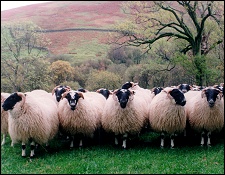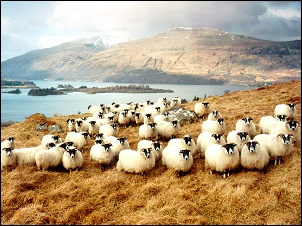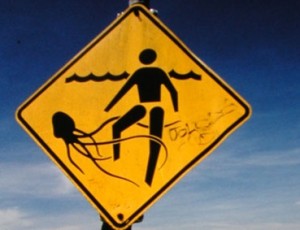
“Blackface lamb is naturally reared, symbolising the purity and goodness of the land and has a reputation for its unrivalled sweet flavour and tenderness. Available from September onwards, it is without doubt ‘ naturally good ‘.”


2022 Archive of RENATURED, Marina Zurkow's Research Blog
ANIMALS, PEOPLE AND THOSE IN BETWEEN

“Blackface lamb is naturally reared, symbolising the purity and goodness of the land and has a reputation for its unrivalled sweet flavour and tenderness. Available from September onwards, it is without doubt ‘ naturally good ‘.”

Morpeth,
Living amid the woods and waters…
A Coaching Stop on the London-Edinburgh route which crossed the ‘moors-path’
Alternatively called the `Murder Path’ from the times of the border reivers (basically robber barons) (1400-1600). Somewhat akin to the Wild West.


“Giant pandas are ‘charismatic megafauna,’ a category that includes whales and other sea mammals, salmon and other inspirational fish, eagles and other flashy raptors. In each instance, the creatures help spotlight the hundreds of humbler but equally endangered species: the black-spored quillwort, the longhorn fairy shrimp.”
—”Birth and Rebirth,” USA Today, August 23, 1999
Usually thought of as poster children for environmental issues, they’re often super cuddly or super scary. Or both (like polar bears).
I’d add to this list:
Jellyfish (alien death squad)
Squirrels (mischievous urban representatives)
But people look at me funny if I start geeking out about plankton or mycelial networks (although the latter can get pretty trippy). If we could spin them right, they’d be seen for the superheroes they are.
More on the Uncharismatic Poster Children:

Mycelium Running:
How Mushrooms Can Help Save the World
and Paul Stamets’ talk from TED:
Animals that eat jellyfish also eat plastic bags
Animals that eat plankton or fish eggs also eat plastic pellets
Animals that eat fish also eat plastic.

MSNBC posted a story on April 9, about leatherback turtles’ diet of plastic bags.
A new study looked at necropsy reports of more than 400 leatherbacks that have died since 1885 and found plastic in the digestive systems of more than a third of the animals.
Leatherback turtles are critically endangered and highly charismatic creatures. They are big, weighing 1,000 pounds or more, with shells that can measure more than 6 feet across. These peaceful creatures have had the same basic body plan for 150 million years.
Leatherbacks are also popular for what they eat: namely, large quantities of jellyfish. The problem is that plastic bags look a lot like jellyfish, and plastic often ends up in the oceans, piling up in areas where currents — and turtles — converge.
Plastic can block a turtle’s gut, causing bloating, interfering with digestion, and leading to a slow, painful death. “I can’t imagine it’s very comfortable,” he said. “Their guts weren’t designed to digest plastic.”
There are vast fields of trash floating in the world’s oceans, Sasso added. And leatherback turtles travel thousands of miles each year, giving them even more opportunities to come in contact with it.
“This is an animal that has survived many extinction events,” James said, “And now it’s got all these anthropogenic hazards to face.”
And there’ve been a spate of publications on the amount of plastic – both nurdles, which are plankton or fish-egg -sized industrial plastic pellets from manufacturing shopping bags, dollar-store articles, and construction material that ends up in the oceans, and consumer plastic (bottles, bags, buckets, etc), which breaks down into ever-smaller pieces but does not completely degrade. This stat is from 2001:
There is now six times more plastic debris in part of the North Pacific Ocean than zooplankton, the populous animal plankton that forms the base of the aquatic food chain.
– C. J. Moore, S. L. Moore, M. K. Leecaster and S. B. Weisberg (December 2001). “A Comparison of Plastic and Plankton in the North Pacific Central Gyre”, Marine Pollution Bulletin 42)
Granted this statistic has been rejected because it only reflects an analysis made in the Pacific Gyre, a confluence of currents and thus a concentration of the contents of what’s carried on them; but even so, the volume of plastics is not decreasing. Some solutions: don’t take plastic bags, get refillable canteens for water. Reconsider the purchase of synthetics which may discharge plastics on the manufacturing process. Consider what else you can do with the plastics you are about to throw in the garbage.
If fish are eating plastic nurdles, then so are we if we eat fish.
Here’s more nurdle info:
http://www.nurdlesaretheenemy.com/
http://theurbancoaster.com/index.php?option=com_content&view=article&id=179&Itemid=92&lang=en
http://ewasteguide.info/more-plastic-plankto
It’s spring break the oceans over.

Australia’s beaches regularly host many types of toxic gelatinous animals, including the notorious Portuguese Man-of-War and Chironex fleckeri, a type of box jellyfish that is the world’s most venomous animal; a Chironex can kill a person in under three minutes.
In addition, some species of potentially deadly box jellyfish known as Irukandji jellyfish are currently increasing in number in Australian waters, possibly because of climate change. These peanut-sized jellyfish are small enough to slip through nets that protect Australia’s beaches from their larger Chironex cousins.
–The National Science Foundation
The National Science Foundation has published an extensive report on the Dead Zone/jellyfish connections, but I thought I’d quote the article’s description of the upsides of jellyfish:
ECOLOGICAL ROLES OF JELLYFISH
Plying the world’s oceans for over 500 million years, gelatinous creatures have influenced marine communities almost as long as marine communities have existed.
As prey, gelatinous creatures are eaten by seabirds, pink salmon, sun fish, turtles and other gelatinous creatures. (Animals that eat jellyfish are not impacted by their stings.) As predators, gelatinous creatures eat fish eggs and larvae, invertebrates, small, floating creatures called zooplankton and other gelatinous creatures.
Scientists are continuing to identify new ecological services provided by jellyfish. For example, recent studies show that the tentacles dangling from the Bering Sea’s large jellyfish provide hiding places for young pollock that are pursued by other predators but have grown too big for the jellyfish to eat.
…This last upside, while über poetic (Jellyfish-as-beaded-curtain; Quick! let’s duck out of harm’s way and hide in this undulating petticoat) does make me wonder if the upsides are outweighed by an anvil-load of problems.